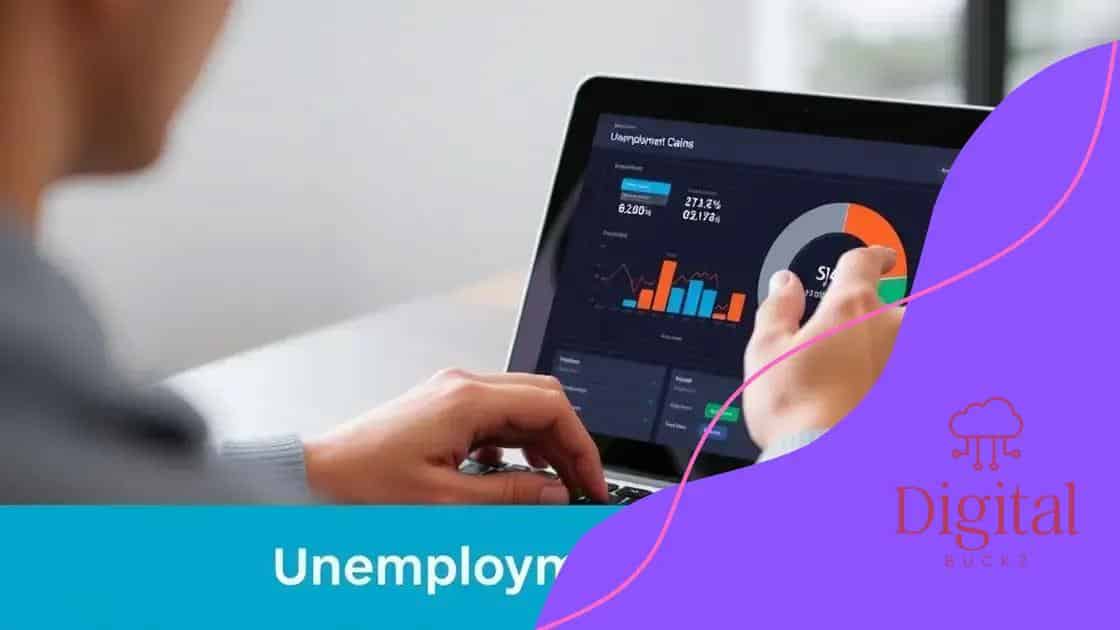The evolution of unemployment benefits in a digital age

The evolution of unemployment benefits in a digital age focuses on using technology to streamline the application process, personalize support, and address accessibility, ensuring individuals receive timely and effective assistance during job loss.
The evolution of unemployment benefits in a digital age is reshaping how we support individuals during tough times. Have you ever wondered how technology can simplify the process and enhance accessibility? Let’s dive in!
Understanding traditional unemployment benefits
Understanding traditional unemployment benefits is essential for grasping how support systems have evolved. These benefits are designed to assist individuals who have lost their jobs through no fault of their own. Historically, unemployment benefits have provided a financial cushion, allowing people time to seek new employment without the immediate stress of daily expenses.
How Traditional Benefits Work
In many countries, unemployment benefits are funded through employer taxes. When a person qualifies for these benefits, they receive a portion of their previous salary for a limited time. The goal is simple: support individuals and families during their transition between jobs.
Key Features of Traditional Unemployment Benefits
- Eligibility criteria, including work history
- The duration for which benefits can be claimed
- The amount of benefits based on previous earnings
It’s important to note that traditional unemployment benefits are not meant to provide endless support; rather, they are a temporary solution to help individuals regain their footing. They can vary significantly by state or country, reflecting local economic conditions and policies.
The application process can sometimes be complicated, requiring specific documentation and a clear demonstration of job loss. Many people may feel overwhelmed and unsure of how to navigate it. Knowing the basics of traditional unemployment benefits can help alleviate some of this confusion.
As we explore the impact of technology on these systems, it’s helpful to remember the core values of traditional benefits. They aim to provide stability, promote economic recovery, and ensure that those in need have access to essential resources. Understanding these foundations sets the stage for appreciating how innovation can enhance these systems today.
The role of technology in benefit distribution
The role of technology in benefit distribution has become increasingly important as we navigate the challenges of the digital age. Technology is streamlining processes and making it easier for individuals to access unemployment benefits. From online applications to automated systems, we see how technology makes a difference.
Digital Applications
Applying for benefits can be daunting, but online applications simplify the process significantly. Individuals can fill out their information from the comfort of their homes, reducing the need for in-person visits. This shift not only saves time but also improves accuracy in data collection.
Automated Systems
Automated systems play a crucial role in processing claims quickly and efficiently. These systems verify information and calculate benefits without human intervention, leading to faster approvals. However, it’s essential to keep in mind that while automation enhances speed, there remain concerns about human oversight.
- Reduced wait times for applicants
- Increased efficiency in processing claims
- Minimized human errors in data handling
Moreover, technology enables better communication channels between the government and the unemployed. Notifications through emails and apps ensure that individuals stay informed about their claims. For instance, real-time updates help applicants know their claim status, reducing anxiety around the process.
The integration of advanced technologies also helps in gathering and analyzing data. Governments can track unemployment trends more effectively, adjusting policies in response to real-world data. This function strives to enhance support systems based on collective needs.
Overall, the impact of technology on benefit distribution is transformative. As we move forward, it’s vital to ensure that these systems remain accessible and inclusive for all, allowing everyone to benefit from available resources.
Digital tools for tracking unemployment claims

Digital tools for tracking unemployment claims have revolutionized the way individuals manage their benefits. These tools provide real-time insights, allowing applicants to monitor their claims conveniently. Many people now rely on these resources to navigate the complexities of the unemployment system.
Benefits of Tracking Tools
One of the key advantages of using digital tools is the accessibility they offer. Individuals no longer need to make long phone calls or visit offices to get updates. With just a few clicks, they can see where their claim stands in the process. This feature helps reduce frustration and uncertainty.
- Real-time updates on claim status
- Immediate notifications for required actions
- Easy access to application history
Moreover, digital tracking tools usually have user-friendly interfaces. It’s easier for users to understand their claim status, as most systems present information in a clear and simple format. Users can quickly identify if they need to provide additional documentation.
Enhanced Communication
These tools also promote better communication between the applicant and the agency. Many platforms include messaging features that allow users to ask questions directly. This direct line of communication leads to quicker resolutions and a more efficient process overall.
Furthermore, tracking tools often incorporate FAQs and chatbots. These features provide instant answers to common questions, reducing the need for human assistance. This saves time for both users and agency staff, allowing resources to focus on more complex inquiries.
As we advance, it is crucial for unemployment agencies to continue investing in technology that enhances these tools. Keeping them updated and user-friendly will ensure that individuals can easily navigate the often-overwhelming process of claiming benefits.
Challenges of digital unemployment systems
Challenges of digital unemployment systems highlight the issues that arise as technology becomes more integrated into the job support framework. While digital systems have improved efficiency, they also present several obstacles for users and administrators alike. Understanding these challenges can lead to better solutions for everyone involved.
Accessibility Issues
One major challenge is the lack of access to technology. Not everyone has a reliable internet connection or the necessary devices to use online systems. This gap can prevent individuals from applying for or managing their claims efficiently. Digital divide issues can leave many vulnerable populations struggling to access essential services.
User Experience Concerns
User experience also plays a critical role in the effectiveness of digital unemployment systems. If the interface is confusing or difficult to navigate, users may become frustrated and give up on their claims. Simplifying these interfaces is crucial to ensure that applicants can find the information they need.
- Long loading times that can deter users
- Poor navigation can lead to incomplete applications
- Insufficient instructions can cause uncertainty
Moreover, when these systems encounter technical problems, it can delay benefit processing. Applicants may face unnecessary wait times due to software glitches or outages. This situation can be particularly stressful for those who rely on these benefits to meet their immediate needs.
Data Privacy and Security
Another significant challenge involves ensuring data privacy and security. With more personal information stored online, there is a higher risk of data breaches. It’s essential for agencies to implement robust security measures to protect sensitive information from cyber threats.
As digital unemployment systems continue to evolve, addressing these challenges will be vital for creating a more equitable and efficient support system. By focusing on accessibility, user experience, and security, we can enhance the way unemployment benefits are delivered and manage future obstacles proactively.
Future trends in unemployment benefits
Future trends in unemployment benefits are shaping how we support individuals facing job loss. As the world evolves, so do the systems designed to provide aid and security. Understanding these trends can help us prepare for what’s to come in workforce support.
Increased Use of Technology
One major trend is the growing reliance on technology to streamline benefits distribution. Online platforms are becoming standard, making it easier for people to apply and manage their claims. With advancements in artificial intelligence, systems can quickly analyze applications and provide faster decisions.
Personalization of Benefits
The personalization of unemployment benefits is another exciting development. Instead of a one-size-fits-all approach, future systems are likely to tailor support based on individual needs. This might include offering additional training resources or job placement services, helping recipients not just receive benefits but also re-enter the workforce effectively.
- Customized support based on job industry
- Access to skill-building programs
- Job matching services connecting applicants with employers
Additionally, tracking tools will likely become more intuitive. Users may receive personalized notifications and updates about their claims, enabling them to manage their benefits more effectively. Keeping beneficiaries informed about the process promotes transparency and builds trust in the system.
Focus on Mental Health and Well-being
Another trend gaining traction is the emphasis on mental health and well-being. Recognizing the stress that unemployment can cause, future benefits systems may incorporate mental health support. This could include access to counseling services or resources to help individuals cope during their job search.
As we move forward, data privacy will remain a key concern. With the increase in digital interactions, ensuring that individuals’ personal information is secure will be crucial. Agencies will need to invest in robust security measures to protect sensitive data and build confidence in these systems.
FAQ – Frequently Asked Questions about Unemployment Benefits in a Digital Age
What role does technology play in unemployment benefits today?
Technology streamlines the application process and improves communication, making it easier for users to manage their claims and receive support.
How can digital tools help track unemployment claims?
Digital tools provide real-time updates, simplify claim management, and enhance communication between applicants and agencies.
What are the challenges associated with digital unemployment systems?
Some challenges include accessibility issues, user experience concerns, and ensuring data privacy and security for personal information.
What trends are emerging in the future of unemployment benefits?
Future trends include increased use of technology, personalization of benefits, and a focus on mental health support for individuals facing job loss.






